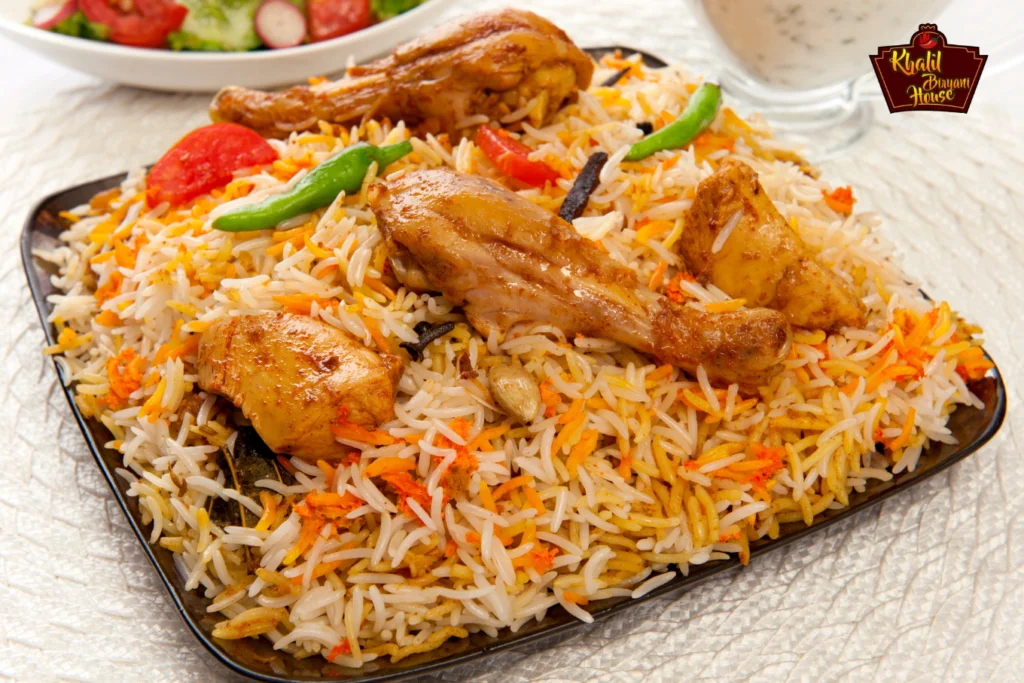Before we zoom in on the calorie numbers, let’s remember what makes chicken biryani so incredibly tasty. It’s a beautiful mix of fluffy rice (often long-grained and fragrant, like basmati rice), tender pieces of chicken that have soaked up lots of yummy spices, and often other goodies like caramelized onions, fresh mint, a swirl of yogurt, and sometimes even potatoes or boiled eggs. Each of these ingredients of chicken biryani adds its own flavor and, yes, its own set of biryani calories.
The Big Question: Cracking the Calorie Code of Calories in Chicken Biryani
Okay, the moment we’ve been waiting for: how many calories in chicken biryani? Just like asking how tall a building is, the answer isn’t always one simple number. It depends on a few important things:
- How Much You’re Eating (Portion Size): Imagine you have a small scoop of ice cream versus a huge bowl – the number of calories will be different, right? The same goes for chicken biryani. A small serving will have fewer calories per serving biryani than a large, heaping plate.
- What’s Actually Inside (Ingredients): Think about a plain sandwich versus one with lots of cheese and mayonnaise. The extra ingredients add more calories. In chicken biryani, things like the amount of oil or ghee (a type of butter) used for cooking, the type of chicken (with or without skin), and even the extra vegetables can change the calorie count chicken biryani.
- Where It’s Made (Homemade vs. Restaurant): Just like your grandma’s cookies might be different from store-bought ones, homemade chicken biryani calories can be different from restaurant chicken biryani calories or what you get as takeaway chicken biryani calories. Restaurants sometimes use more oil to make the biryani extra flavorful, which can bump up the fat content chicken biryani and the overall calorie count.
So, with all these things in mind, a typical serving (around one cup) of chicken biryani might have somewhere between 300 and 500 biryani calories. But remember, the size of the serving you actually eat can make a big difference. A large restaurant portion could easily have more!
Beyond Just Calories: What Else is in Your Biryani?
Calories are like the energy button for our bodies, but food also gives us other important things. Let’s look at some of the other nutritional value chicken biryani offers:
- Protein Power: The chicken in biryani is a good source of protein, which helps our bodies grow strong and repair themselves. The protein in chicken biryani is a big plus!
- Energy from Carbs: The basmati rice gives us carbohydrates, which are like fuel for our bodies to run and play. The carbohydrates in chicken biryani come mainly from the rice.
- Fats: The Flavor Carriers: There are fats in biryani, mostly from the oil or ghee used in cooking and the chicken itself. Some fats are good for us, but too much of certain kinds isn’t the best. Understanding the fat content chicken biryani helps us make smart choices.
- Hidden Helpers (Vitamins and Minerals): The onions, garlic, ginger, and other spices in biryani add not just flavor but also small amounts of vitamins and minerals that our bodies need to stay healthy.
Making Biryani a Little Lighter: Smart Swaps
Love chicken biryani but want to keep an eye on the calorie count chicken biryani? Here are a few simple ideas for making a healthy chicken biryani or a low calorie chicken biryani:
- Less Oil, Please! Using less oil or ghee when cooking can make a big difference to the overall calories per serving biryani. Try using cooking sprays or just a drizzle of healthy oil.
- Veggie Power-Up! Adding more vegetables like carrots, peas, beans, and cauliflower can make your biryani more filling without adding a lot of extra biryani calories.
- Lean Chicken Choices: Opt for chicken breast without the skin instead of fattier pieces. This reduces the fat content chicken biryani.
- Portion Patrol! Being mindful of how much chicken biryani you’re putting on your plate is one of the easiest ways to control your calories in one plate biryani or calories in a bowl of biryani.
- Brown Rice Option: If you’re feeling adventurous, try making biryani with brown rice instead of white rice. It has more fiber and can be a healthier choice, although it will change the texture and taste a bit.
Restaurant vs. Homemade: The Calorie Showdown
We talked a little about this, but it’s worth repeating: the calories in restaurant chicken biryani and takeaway chicken biryani calories can often be higher than homemade chicken biryani calories. This is usually because restaurants might use more oil to get that rich taste and often serve larger portions. If you’re eating out, maybe share a portion with a friend or ask if they have a smaller serving size.
Exploring Different Biryani Styles and Their Calories
Did you know there are so many delicious types of biryani? From the spicy Hyderabadi biryani to the fragrant Lucknowi biryani, each style has its own unique ingredients and cooking methods. This means the average calories in biryani can vary depending on the specific type. For example, a biryani made with more meat and richer sauces might have more calories than a simpler vegetable and chicken biryani.
How Does Biryani Fit into a Balanced Meal?
Chicken biryani can definitely be part of a balanced meal! Just think about what else you’re eating with it. Adding a side salad or some yogurt can help make it a more complete and balanced meal. Being aware of the nutritional value chicken biryani helps you make choices that fit your overall eating plan.
Want to Know More? Tools to Help You Explore
If you’re really curious about the specific calorie count chicken biryani from your favorite restaurant or a recipe you found online, you can use an online calorie counter biryani. There are many websites and apps where you can search for common foods or even enter the ingredients of a homemade dish to get an estimate of the calories in biryani.
Thinking Bigger: Calories in Other Similar Dishes
Chicken biryani is a star in Indian rice dish calories, but there are other tasty rice dishes out there too! Things like pulao, fried rice, and different kinds of mixed rice dishes will all have their own calorie counts depending on what goes into them. Similarly, when we think about South Asian food calories in general, it’s a big and varied world, with each dish having its own unique nutritional profile.
Our Gentle Exploration Comes to a Close
So, we’ve taken a friendly peek into the world of calories in chicken biryani. We’ve learned that it’s not just one number, but rather a range that depends on how it’s made and how much we eat. By being a bit of a food detective and thinking about ingredients and portion sizes, we can enjoy this delicious dish in a way that feels good for our bodies. Remember, it’s all about finding a balance and understanding what our food gives us!
Frequently Asked Questions About Chicken Biryani Calories:
- What’s a ballpark figure for the average calories in a standard serving of chicken biryani? A common estimate for a standard serving (around 1 cup) is between 350 and 450 calories.
- Does the type of rice used significantly impact the calorie count? While different types of rice have slightly different nutritional profiles, the main impact on the calorie count chicken biryani comes from the added fats and other ingredients, rather than just the type of rice. However, brown rice has more fiber, which can be beneficial.
- If I’m trying to lose weight, should I avoid chicken biryani? Not necessarily. You can still enjoy it in smaller portions and by making healthier swaps in the recipe to create a low calorie chicken biryani. Being mindful of the overall calorie count chicken biryani for your meal is key.
- Are vegetarian biryanis always lower in calories than chicken biryani? Not always. If a vegetable biryani is made with a lot of oil or rich sauces, it could have a similar or even higher calorie count than a chicken biryani made with leaner chicken and less fat.
- How can I estimate the calories in chicken biryani from a restaurant if they don’t provide nutritional information? You can try using online calorie counters for similar dishes from other restaurants as a general estimate, but keep in mind that actual values can vary.
- Do the spices in chicken biryani add many calories? Spices themselves are very low in calories and contribute more to the flavor and potential health benefits than to the overall calorie count chicken biryani.
- What’s a good portion size for chicken biryani if I’m watching my calorie intake? Starting with a ½ cup to ¾ cup serving and pairing it with a large salad or yogurt can be a good way to enjoy it while being mindful of calories.
- Are there any low-calorie vegetables that work well in chicken biryani? Yes, adding vegetables like cauliflower, broccoli, carrots, peas, and green beans can increase the volume and nutrients without significantly increasing the biryani calories.
- Does marinating the chicken affect the calorie count? The marinade itself (usually yogurt and spices) adds a minimal amount of calories. The main calorie contribution comes from the chicken and the cooking oil.
- Besides calories, what other nutritional aspects of chicken biryani should I be aware of? It’s good to be mindful of the fat content, especially saturated fat, and the carbohydrate content from the rice. Also, consider the protein from the chicken and the fiber content, which can be increased by adding more vegetables or using brown rice.


